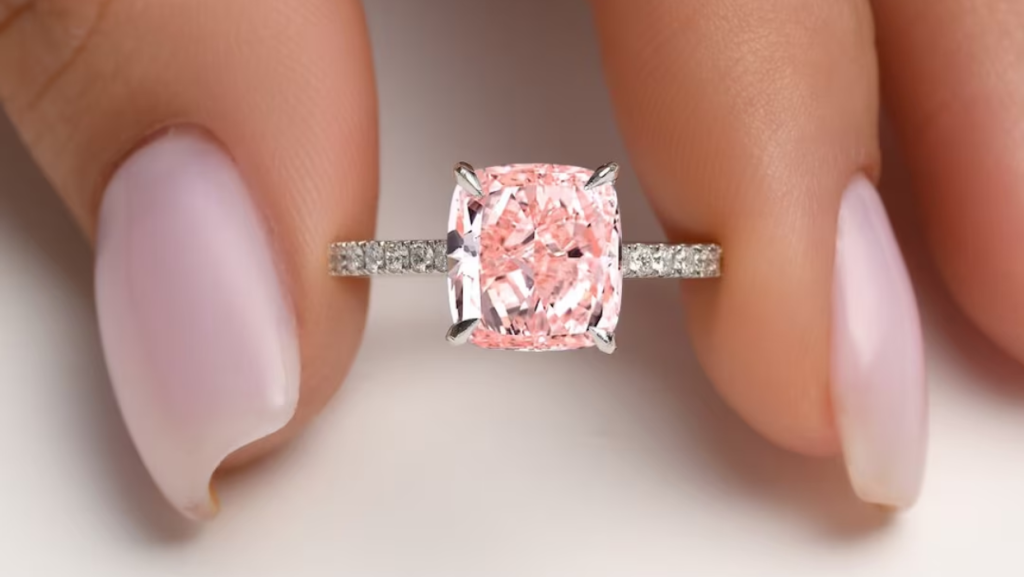When choosing a gemstone for fine jewelry, particularly engagement rings, the debate between diamond vs white sapphire often arises. While both gemstones exude beauty and sophistication, their differences in brilliance, durability, and ethical considerations make them unique. Adding lab-created diamonds into the mix offers a sustainable, cost-effective alternative that competes directly with both traditional diamonds and white sapphires. Let’s delve into the key differences to help you make an informed choice.
Table of Contents
Diamonds: Timeless Brilliance
Diamonds are renowned for their unmatched sparkle and durability. They have long symbolized luxury, eternal love, and prestige. With advancements in technology, lab-created diamonds now offer the same brilliance and physical properties as mined diamonds, often at a fraction of the cost.
Key Characteristics of Diamonds
- Hardness: Diamonds are the hardest natural material, scoring a 10 on the Mohs scale. This makes them exceptionally durable and resistant to scratches.
- Brilliance: Diamonds possess superior light performance, showcasing fire, scintillation, and brilliance.
- Versatility: Diamonds are available in a wide range of shapes, cuts, and sizes to suit different preferences.
Lab-Created Diamonds vs. Natural Diamonds
Lab-created diamonds are chemically, physically, and optically identical to mined diamonds. The only difference lies in their origin:
- Sustainability: Lab-created diamonds are produced with significantly less environmental impact than mining.
- Affordability: Typically 20-40% less expensive than mined diamonds of similar quality.
- Ethical Production: Free from the ethical concerns associated with conflict diamonds.
White Sapphire: A Budget-Friendly Alternative
White sapphires, a variety of the mineral corundum, are a popular diamond substitute. Unlike diamonds, they lack the same level of brilliance but offer a unique aesthetic and affordability.
Key Characteristics of White Sapphires
- Hardness: White sapphires score a 9 on the Mohs scale, making them durable but slightly less scratch-resistant than diamonds.
- Brilliance: White sapphires have a more subdued sparkle, as they reflect light differently than diamonds. Their brilliance is often described as “milky” or “frosty.”
- Affordability: White sapphires are significantly less expensive than both mined and lab-created diamonds, making them an attractive choice for budget-conscious buyers.
Appearance and Maintenance
While white sapphires are beautiful, they require more maintenance than diamonds. Over time, their surface can develop a cloudy appearance, necessitating frequent cleaning to maintain their luster.
Diamond vs. White Sapphire: Key Comparisons
Brilliance and Sparkle
- Diamond: Renowned for its brilliance and ability to refract light, resulting in a dazzling sparkle. Lab-created diamonds match this brilliance perfectly.
- White Sapphire: Offers a softer, more understated sparkle that lacks the fire and scintillation of a diamond.
Durability
- Diamond: Exceptional hardness makes it ideal for everyday wear, especially in engagement rings.
- White Sapphire: Durable but more prone to scratches and surface clouding over time.
Cost
- Diamond: Natural diamonds are the most expensive option, but lab-created diamonds provide a cost-effective alternative with identical qualities.
- White Sapphire: Significantly more affordable than both natural and lab-created diamonds, making it a practical choice for those on a tight budget.
Ethical and Environmental Considerations
- Lab-Created Diamonds: Environmentally friendly and ethically produced, lab-grown diamonds eliminate the concerns associated with diamond mining.
- White Sapphire: Generally more sustainable than mined diamonds but lacks the same level of transparency in sourcing as lab-created diamonds.
Why Choose Lab-Created Diamonds?
Lab created diamonds are the ideal choice for those seeking brilliance, durability, and sustainability without the high cost of mined diamonds. They bridge the gap between the timeless appeal of diamonds and the affordability of white sapphires. Here’s why lab-grown diamonds stand out:
- Identical to Mined Diamonds: Lab diamonds share the same composition and brilliance as natural diamonds.
- Ethical Luxury: Free from conflict and produced with minimal environmental impact.
- Affordable Elegance: Offers better value, allowing consumers to purchase larger or higher-quality stones.
Conclusion: Finding the Right Gemstone for You
The choice between diamonds, white sapphires, and lab-created diamonds ultimately depends on your priorities. If brilliance, durability, and timelessness are non-negotiable, diamonds—especially lab-created ones—are the way to go. For those seeking a more affordable and unique alternative, white sapphires offer understated elegance.
Lab-created diamonds, in particular, combine the best of both worlds: the unparalleled brilliance of natural diamonds and the ethical and environmental advantages modern consumers value. Whether you’re investing in an engagement ring or a statement piece, lab-created diamonds ensure you don’t have to compromise on beauty, ethics, or budget.
